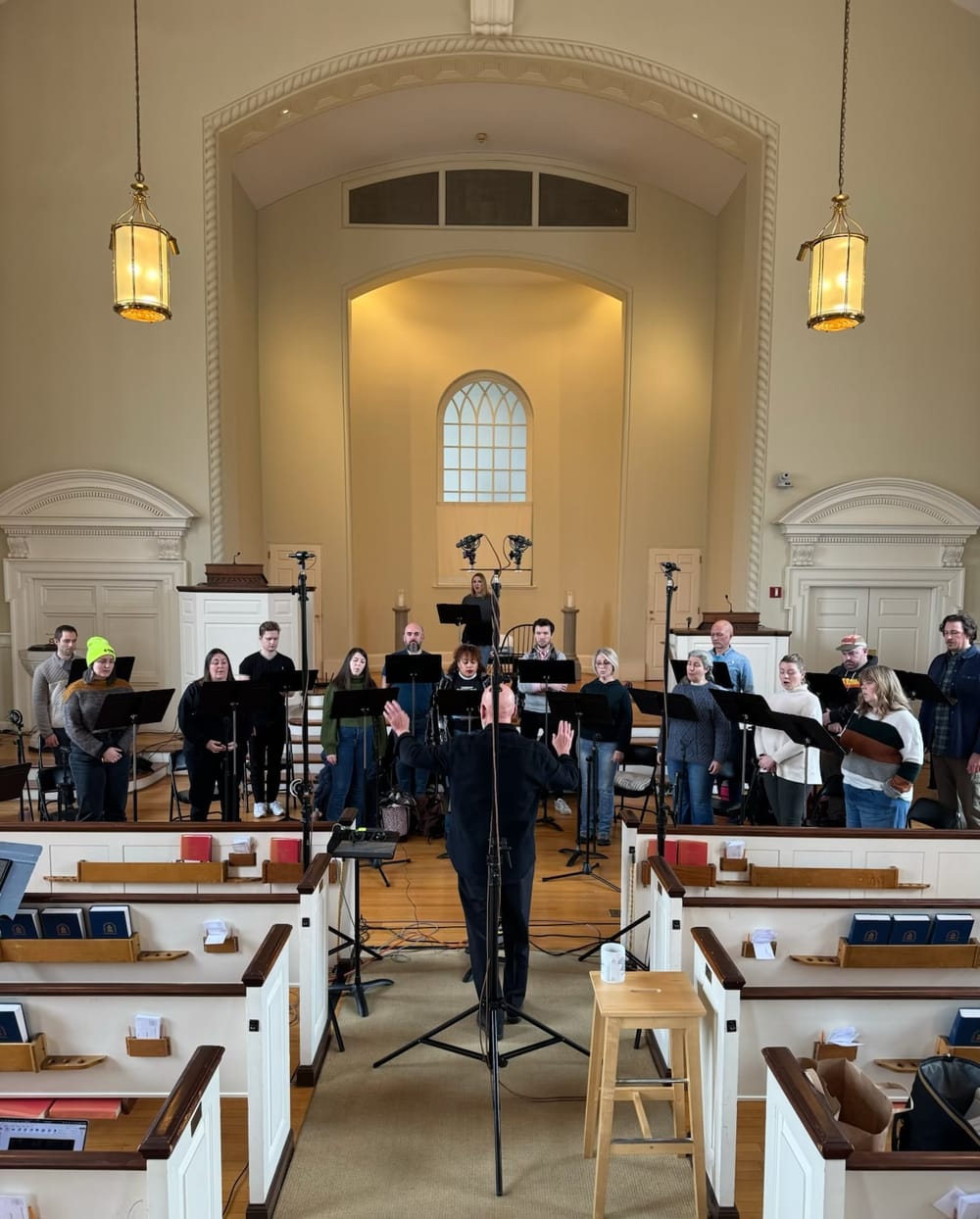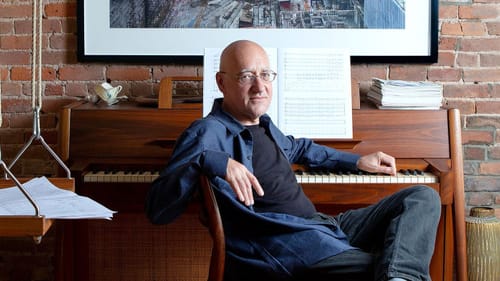Stay in the Loop
BSR publishes on a weekly schedule, with an email newsletter every Wednesday and Thursday morning. There’s no paywall, and subscribing is always free.
“America’s most interesting choir” lives up to its reputation
The Crossing presents what can I know?

Many ensembles celebrate an anniversary by commissioning a work or two. But for The Crossing, its 20th season, titled Transcendental Idealists, continues as usual, studded with new and newly commissioned music. On February 7, 2025, Donald Nally and the ensemble presented what can I know?, a concert of three works that included Sebastian Currier’s Mysterium (in a world premiere) and the North American premiere of Linda Catlin Smith’s Folio.
The ensemble led with Smith’s Folio, a 2023 mesmeric setting of poetic fragments by Emily Dickinson (1830-1886), written for a professional choir in Ireland. The composer created an affecting libretto from these elliptical phrases, some recognizable from her poems (like “a great hope fell”) and some snippets that Dickinson wrote on used envelopes. The musical ideas are often well-realized, but the repetition in this formless work gives it a sense of stasis, perhaps the composer’s intention. Occasionally, a lone voice cries out harshly, underlining the poet’s sense of longing or despair. Smith often has the chorus drop away, and she extends the musical line via a solo voice, creating a hanging thread of sound that mirrors the way Dickinson’s own thoughts often evaporate, unresolved.
A previous Nally commission
Next, the ensemble reprised three movements (III, IV, and V) from Robert Convery's 1993 Voyages. Its evocative poetic text is taken from six imagistic love poems of the same name by Hart Crane (1899-1932). This was the first major work commissioned by Nally during his tenure as choral director at West Chester University. It’s a musically and textually accessible composition in which Convery skillfully balances and undergirds Crane’s emotional, fragmentary text with interweaving choral harmonies. Crane wrote Voyages as a paean to his lover, the sailor Emil Opffer, and the complex poetry is filled with sea and water images. The work ended with an eloquent setting of the poet’s evocation to “draw in your head and sleep the long way home.”
The composer, the physicist, and the writer
After intermission came the evening’s centerpiece, Currier’s ambitious Mysterium. The impetus for the 2024 work came when Currier was composer-in-residence at Princeton’s renowned Institute for Advanced Study, the prominent center for theoretical research (home of scientists like Einstein and Oppenheimer) that continues to foster intellectual inquiry. There, Currier—interested in the intimate interconnection of science and music—met Dutch physicist (now government minister) Robbert Dijkgraaf and his wife, noted novelist and memoirist Pia de Jong.

Intertwining the duo’s works and world views, the composer crafted this piece for chorus and prepared electronics. The text and soundscape of the 45-minute work alternate between the physicist’s cosmological consideration of the universe—“the farther out in space we look, the further back in time we see”—and the writer looking inward as she reflects on the couple’s first meetings. Both of these texts explore (and revolve around) the randomness of the universe and of our individual actions.
Virtuosity and melodrama
In the 1960s, scientists discovered that we are surrounded by faint radiation, the remains of light released after the universe began, called the Cosmic Microwave Background (CMB). Currier explains that in his composition, the CMB “has been converted into sound waves ... with subtle variations. These electronic sounds surround the chorus, making the inaudible audible.”
Mysterium begins with this white noise, which varies throughout the work from gently embracing at the opening to aurally strident by the work’s close. It creates an alien-like soundscape—often compositionally quoting prepared electronic tape compositions heard in the 1970s—interspersed with a cappella solo and choral sections sung with the virtuosity and musical detail for which The Crossing is noted. Throughout, the chorus sang the words of the physicist, and soprano Rebecca Myers sang the writer's words. It was at first interesting to have these often chorally beautiful passages regularly intersected by the prepared electronics, but it became somewhat repetitive and melodramatic as the work intensified, causing some audience members to cover their ears.
Throughout, the work was illuminated with colored lights that changed from icy blue for the cosmological sections to warmer golds and pinks for the writer’s personal observations. While this added some dimension to the piece, it was a simplistic and rudimentary treatment, compared to the artistry of the singing. A heightened and professional lighting design would have more effectively enhanced this work.
The choral equivalent of abstract artists
This ensemble explores extensions of the choral form in much the same way as abstract visual artists push the boundaries of their genre, a worthy and important experimental pursuit that sometimes makes for challenging listening. They have been lauded (accurately) as “America’s most interesting choir” and just received their fourth Grammy Award for the 2022 recording titled Ochre. Much like a sports team we know, The Crossing has a cadre of devoted followers who eagerly await what their choral “team” will accomplish next. The Grammy Award and this concert were milestones that the loyal audience was excited to experience and celebrate.
At top: The Crossing in rehearsal for Sebastian Currier’s Mysterium, performed at the Presbyterian Church of Chestnut Hill on Friday, February 7, 2025. (Photo by Naomi Bennett, courtesy of The Crossing.)
What, When, Where
what can I know? Sebastian Currier, Mysterium; Robert Convery, Voyages; Linda Catlin Smith, Folio. Conducted by Donald Nally. The Crossing. February 7, 2025, at the Presbyterian Church of Chestnut Hill, 8855 Germantown Avenue, Philadelphia. crossingchoir.org.
Accessibility
The Presbyterian Church of Chestnut Hill is wheelchair accessible, and The Crossing provided both printed programs and projected text.
Sign up for our newsletter
All of the week's new articles, all in one place. Sign up for the free weekly BSR newsletters, and don't miss a conversation.

 Gail Obenreder
Gail Obenreder